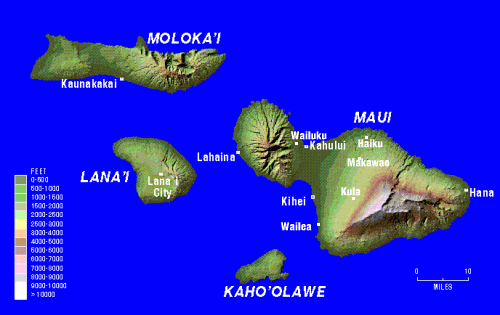Maui is on of the most beautiful islands in the world. Beautiful beaches, world-class resorts, a majestic Haleakala and more, Maui has it all. The wonders of Maui, the second largest of the Hawaiian Islands, are many. The historic town of Lahaina once claimed the title as the major whaling center of the Pacific.
Today, people come for history, whale museums, art and just to relax and soak in the sun. People also come to West and South Maui for the fabulous resorts, shopping and the palm tree-fringed beaches of Ka`anapali, Wailea and Kihei.
From the summit of Haleakala, with its behemoth crater, to the trappings of Napili and Kapalua; from the charming towns of Upcountry to the beautiful curves of the road to Hana, the Magic Isle offers residents and visitors alike so much to explore, experience and discover.
South Maui is famous for the nearly four mile stretch of continuous sand from Maalaea to Kihei, the luxury resorts of Wailea and Makena, and Maui's last lava flow: La Pýrouse Bay. West Maui is perhaps the best known section of the island, famous for Kaanapali Beach, luxury resorts, golf courses, and historical Lahainaýthe capital of the Hawaiian Kingdom. Northeast Maui is a secluded wonderland that is lightly traveled, most likely because the state maintained road ends near Kahakuloa. Central Maui is the industrial hub of the island, home to the airport, harbor, and government offices. Central Mauiýwhich includes everything from Wailuku to Haikuýhas many natural wonders, like Iao Valley, Kanaha Pond, and Hookipa windsurfing beach. Upcountry Maui is a mix of Makawao Rodeos, majestic forests, farms, ranches, hiking trails, and one of the biggest attractions on Maui: Haleakala National Park, home of Haleakala Crater, the world's largest dormant volcano. East Maui is best known for the road to Hana. This twisty stretch of pavement winds through over 50 miles of scenic jungle, sea cliffs, waterfalls, and streams. The entire drive is dotted with breathtaking views and historic sites, like Wainapanapa black sand beach, Oheo Pools and Charles Lindbergh's burial place.
Welcome to Molokai, The Most Hawaiian Island. Often called "The Friendly Island" because the aloha spirit flourishes here.
This is an island lost in time. An island where no building is taller than a palm tree. Where aloha is not just a word, it's a way of life. Where the longest white sand beach in Hawai'i will probably have only your foot prints on it. An island where there is so little automobile traffic, there's not a single traffic light. There's no mall, no elevators and no neon. No burger wars here. Shopping is done in small, friendly businesses in Kaunakakai, the largest town, and in the villages of Kualapu'u and Maunaloa. Life here is slow and relaxed. It's rural and peaceful. It's like stepping back in time 50 years. It's a place like no other. |
The island of Kaho'olawe, located seven miles off Maui's south coast, is uninhabited. Following the Japanese attack on Pearl Harbor in 1941, the U.S. government confiscated the island from ranchers to use as a bombing practice site. The U.S. Navy and Air Force bombarded the island until 1990, and in 1993 the U.S. government allocated funds to clean up the island's military waste. In 1994 the island was turned over to the state of Hawai'i, which has established legislation prohibiting all commercial activities on the island, except fishing. There is no infrastructure or landing strip on Kaho'olawe; authorized visitors arrive via small boats. Kaho'olawe has been established as a center for traditional Hawaiian cultural, spiritual and subsistence activities, and work is being done to restore it. It is the smallest of the main islands in the Hawaiian archipelago, at 45 square miles. Its highest point, Puýu Moaulanui, rises to 1,483 feet. |
Locally: 1-808-875-6900
www.mauilimo.com

No comments:
Post a Comment